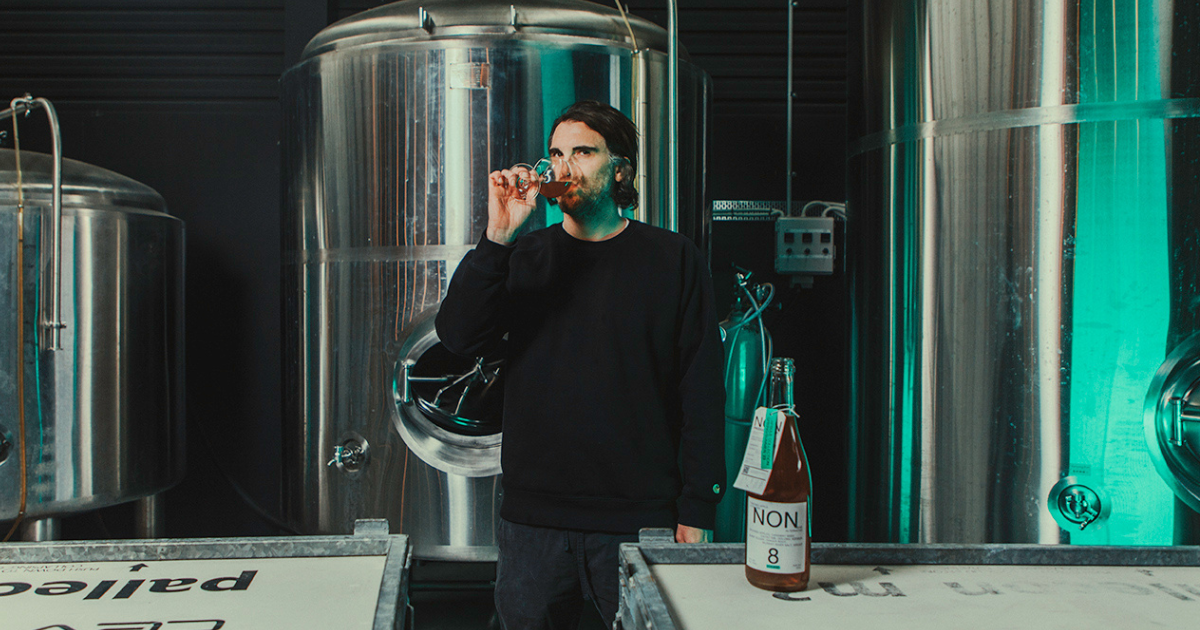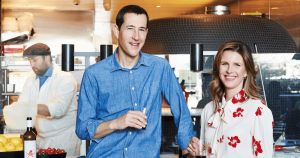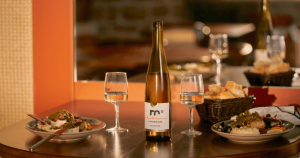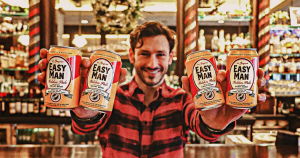Inspired to bottle the essence of fine dining tasting menus, Aaron Trotman, the innovator behind NON, has reimagined the non-alcoholic beverage space. This Q+A delves into his journey of crafting NON’s unique flavor profiles, emphasizing his dedication to premium, globally sourced ingredients, and exploring the challenges of pioneering a novel category within beverage.
What was your initial inspiration to create NON?
The idea for NON was born in November 2017 after my wife Miranda and I were on holiday in Europe. We were visiting fine dining restaurants and enjoying elaborate tasting menus. Miranda doesn’t drink, but the bartenders would carefully craft alcohol-free concoctions to complement the complex dishes being served.
We experienced one temperance pairing at The Clove Club in London, and that was when something clicked for me. I thought it was a real shame that these drinks live and die in these places because they’re not in a bottle. I knew someone needed to do that.
I didn’t have any market research or really know anything about the drinks category. I don’t have a background in the culinary world, either. I have a background in consumer packaged goods in the cosmetics industry. My mentor was the late Richard Gonano, who was the cosmetic chemist behind brands including Aesop and Kevin Murphy. I knew how to blend oils to create scents and fragrances, and I had experience developing formulations and bringing a product to market—and how the ingredient percentages change drastically as you scale production.
NON is about flavor built from the ground up with key notes of fruit, tannin, salinity, and acidity. The ingredients are the highlighted heroes creating a look and feel often seen in fine dining menus. NON creates real drinks for real times.
The name “NON” is quite intriguing. Can you share the story behind choosing this name for your brand?
I wanted NON to be bold, confident, and progressive. The name obviously refers to the product being non-alcoholic, but I think it speaks more to our company’s culture—that we’re nonconforming.
NON doesn’t fit into a box, category, lifestyle, or convention. The finished product might look like wine, but it smells like a chef’s creation and tastes like nothing else in the world. I truly believe that nonconformity shapes the future by breaking ranks with tradition. It makes the decision to shape the future rather than sitting in the past.
Tell us about your approach to formulation.
When I started NON, I contracted a chef to give me a hand with the recipe development. I already felt that I had a very good idea on the formulas and the perfumey-based approach to it. I wanted to make sure the aromas in the drink were balanced, and I was mindful of the challenges of scaling up. But after about three months of development, it didn’t feel like it was going very well, and I pulled the pin on that collaboration.
For the development of NON8, I worked closely with our Head of Kitchen Nick Cozens over the course of two years to fully realize what became the final product. Nick has a background as a chef and moved into cocktail bartending. He’s got an incredible palate and a natural knack for flavors. He understands that these drinks are made for real times and occasions, and thinks about the moment they are going to be consumed while he is creating the recipes.
How do you ensure that each bottle of NON captures the essence and complexity of traditional wines without the alcohol?
NON deconstructs real produce with culinary techniques to create real drinks with no booze.
Instead of following the formula of alcohol-free wines—which strips out the alcohol, and with it, much of the flavor—NON takes a more of a perfumery approach, cooking layers of flavors into the verjus base sourced from chardonnay and semillon grapes from Barossa Valley. That’s the process our team of alchemists (among them: chefs, bartenders, food scientists, and winemakers) continues now, only on a much larger scale.
Your brand emphasizes the use of high-quality, globally sourced ingredients. Can you elaborate on the process of selecting these ingredients and ensuring their quality?
We’re really lucky to have access to a bunch of brilliant Australian producers to help make the products in our range. The fruit we use is transported to us freeze-dried, removing the water and oxygen from the product to lock in the maximum flavor and nutrition for when we’re ready to use it. For NON8, we stayed hyper local and worked with a brilliant orchard on the Mornington Peninsula called Mock Red Hill who provided us with orchard apples.
Not all of our ingredients are Australian-grown, though. We get our yuzu from Japan, because it’s still the best product. We use dried chamomile flowers from Egypt, because they’re unbeatable. What we put into our drinks needs to be the best, and that contributes to why the end product carries the price point it does. We’re using really decent ingredients.
I think what you discover when you try NON is that none of the expressions are dominated by one flavor or ingredient. It’s about finding harmony and balance between the fruit, acid, tannin, and salt. Each of these elements must be premium, and we do use the best ingredients. But, above all, they need to complement each other.
Can you share about the challenges you’ve faced while establishing NON in the market?
There have been a bunch of challenges: scaling up production, the pandemic, finding the right team, and getting buyers to understand what we’re trying to achieve.
The category itself is still in its infancy in every market we seem to enter. Each country has different labeling laws and criteria that present us with different challenges all the time. NON coined the term “wine alternative,” and so a lot of the challenges we face are brand new.
How do you see NON fitting into the broader landscape of non-alcoholic beverages, especially in a market dominated by traditional wines?
I designed NON not to fit in.
There are so many flavors out there to explore, and we’re learning new ways to scale and build these flavors all the time. I think NON will continue to evolve and exist in this genre-bending way. I like that our drinks can confuse and confront.
There are so many strict rules around wine. Wine has to follow rules: labeling rules, appellation rules, varietal rules. Wineries that own vineyards are dependent on climate—and, as we’ve seen in Australia in the last few years, they’re massively affected by fires and floods.
The NON model gives us a bit more flexibility about where we get our fruit and florals, but still allows us to tell a story of seasonal expression with the assurance of always using the best produce out there.
I think that once people understand that dealcoholized wine is a product that is stripped of something, and that NON is a product that is thoughtfully built, we’ll see a shift in our favor. You’re not missing out on anything when you choose to have a glass of NON, you’re saying yes to experiencing more.
You’ve mentioned that NON is not just about replicating wine but offering a unique drinking experience. How do you ensure that each variant offers something distinct to the consumer?
Yeah, that’s right. NON isn’t about replicating wine. We call ourselves a wine alternative, but it’s really because there wasn’t a name for what we were making. It’s its own thing.
Each expression of NON offers the drinker something distinct because we set out to make different drinks for distinct moments. Our Salted Raspberry and Chamomile NON1 is an effervescent, fun, and zippy blush—perfect for a bottomless brunch, or a dessert course. In NON2, we’ve used Caramelised Pear and Kombu (a dried kelp) with salinity from olive brine; it might sound a bit confronting, but we’ve balanced it with ginger, cardamom, and star anise and made a drink that goes incredibly well with dark chocolate or buttery pastries. NON5 uses hops you’d usually find in an IPA alongside hibiscus, lemongrass, and peppermint. It has a citrusy edge that makes it perfect for spicy southeast Asian food.
When we’re coming up with NON recipes, we’re thinking about the meals we love. We’re making these drinks with these real occasions in mind.
How has the reception been for NON, both in Australia and internationally?
The reception has been incredible. We’re so lucky here in Australia to have a thriving hospitality scene that is valued and respected around the world.
Since we’ve started selling NON, restaurants like Quay in Sydney Harbour have championed us for how we complement the dining experience they offer to their customers. In Melbourne, we’re being poured in places like Entrecote, a French Bistro serving NON8 Stewed Cherry and Coffee alongside their incredible steak frites. But you can also find us in the fridges at local pubs like the Builders Arms in Fitzroy and the Victoria Hotel in Footscray.
Internationally, we’re growing so fast. In the US, we’ve just been included on the tasting menu at Alinea which is a real career highlight. We’ve done tasting menus at Eleven Madison Park in New York, and at Hearst Castle in California. Asian audiences can’t get enough of NON. We’re everywhere in Singapore and Japan and are growing in Malaysia and Korea. We also have a heap of interest in the UK.
What’s next for NON? Are there any new flavors or innovations in the pipeline that fans can look forward to?
2023 was huge for us with the opening of NONHQ (the world’s first alcohol-free cellar door) and the release of our first new expression since we launched, the NON8 Torched Apple and Oolong.
2024 shows no sign of slowing down. Our team is working with some incredible chefs on flavor development, and we’re excited to be exploring cross-category collaborations that push the boundaries of what is perceived to be “normal” for a drinks brand to do. Watch this space.
How do you envision the future of non-alcoholic beverages, especially in regions with a deep-rooted wine culture?
The future of non-alcoholic beverages is really exciting and it will continue to grow. People will continue to become more educated about the health risks and dangers of alcohol, and will certainly seek out alternatives like NON that can add value to their dining experiences and to their lives.
NON isn’t anti wine culture. We exist in tandem with it. I don’t think it’s helpful to think of it in a binary way. NON exists in the real world. We want to allow drinkers to be able to choose to have a glass of NON in the middle of their meal. We want people to bring a bottle of NON to a dinner party alongside a bottle of Chablis or Gamay. We want people to enjoy the conversations with their loved ones, to moderate, and to get home safely.
NON is the future of drinks because we respect our customers and give them an alternative to choose from.
___
Dry Atlas is your guide to the world of alcohol alternatives. We maintain the world’s largest directory of non-alcoholic spirits, wines, beers, and more to help you discover options you’ll love. We also publish High Spirits, the weekly newsletter that helps open-minded drinkers like you learn more about non-alc. Our goal is to demystify alcohol alternatives so you can navigate them with ease to pursue a happier, healthier life.






